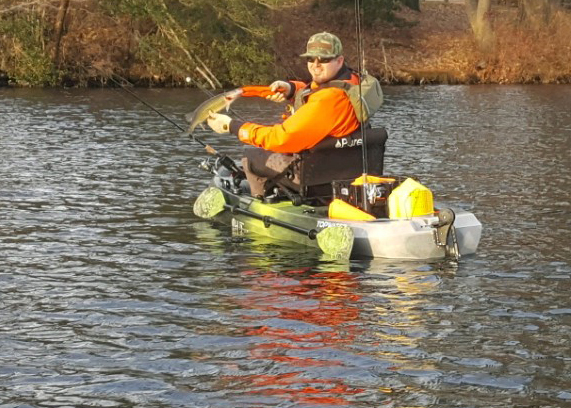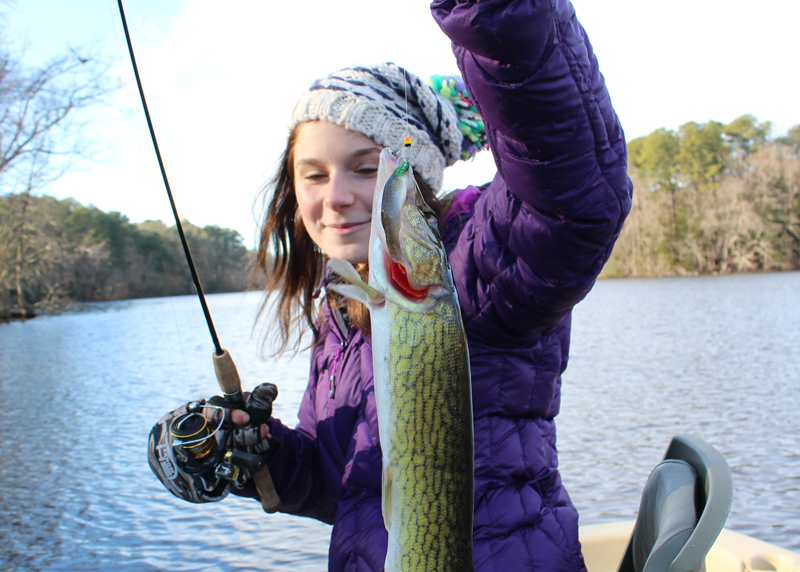Whether you’re exploring a new area, trying to put as many pickerel in the boat as possible, or chasing trophies, it's hard to beat slow trolling live minnows. I’ve spent countless days floating around millponds and other non/low tidal areas in search of pickerel in the dead of winter and nine times out of 10, slow trolling minnows produces first, biggest, and most. It’s effective to the point I can’t bring myself to go out and fish these areas without a bucket of minnows on board as a backup, even if I'm planning on tossing lures that day. That being said, it can be a tricky way to fish, and throughout the years I’ve noticed a significant increase in catches after honing in the technique. Let’s dive into how to send those bobbers sinking one after the other and what you’ll need to make sure these slimeballs make it over the gunnel.

Gearing Up for Pickerel
When slow trolling for pickerel, I have specific preferences when it comes to rigging my gear — to the point that I have a tackle box full of about 20 of the exact same bobbers. As crazy as this may sound, having the right kind of bobber (Thill Balsa Spring Floats are my fav) is the most important piece of the puzzle of learning to slow troll for pickerel. I use a uni-to-uni to tie 15-pound braid to three to four feet of 20-pound fluorocarbon leader. This is leaning towards the larger end of the leader spectrum because pickerel have a mouthful of the best line cutters on the market. Longer leaders will lead to less time retying and more fish in the boat. Then grab some quarter-ounce white bucktails, and lots of them. There's not much worse than getting bit off for the eleventeenth time only to find out you’re out of bucktails during a hot bite, trust me…
If you plan on releasing the fish, as most anglers do with pickerel, please use a rubberized net to protect the fish’s slime coat and prevent injury. Pickerel are an indigenous species to Maryland and the Chesapeake Bay Watershed, one that continues to thrive in our waters. It would be a shame to see their numbers decline as the population of fisherman targeting them continues to increase.
Getting Prepped for Pickerel
Okay: you’ve made it to the spot. At this point, most anglers would plop their bobber a few feet above their bucktail, slap on a minnow, toss it out, and wait. Instead, drop your jig directly under your boat and all the way to the bottom. Reel up six inches to a foot, grab your line where it meets the water, and put your bobber on there. This will place your minnow about a foot off the bottom while you troll, directly where hungry pickerel should be on the prowl. I have found this to be particularly effective when I am focusing on areas with old weed beds that the fish are using as cover. Repeat with as many rods as you plan on using. I generally run two or three rods depending on how much space I have; use any more and you’ll just be fishing for tangles in most cases.
The Wobbling Bobber
This is where our fancy-dancy bobbers come in. Set out your lines in the direction you plan on facing. If I’m in a kayak, I put my lines out in front of my boat and troll backwards. In boats with swivel seats, I'll just swivel the seat backwards. Start moving as slowly as possible, and I mean slooow. With most trolling motors I’ve used while fishing like this, I’ve had to bump it in and out of gear even on the slowest setting. You’ll know you’re going the right speed once your bobber starts to wobble back and forth. Go too fast and it will straighten out in the water. Keeping prime wobble-speed, run across the spot you're covering, focusing on where you have the most strikes. If you don’t catch a fish within a few passes, it’s on to the next spot.

Plan out areas to hit that are close to one another so you can slow troll between them until you’ve found where the fish are concentrated. This can help you find new hot areas since you’re never running over water without a bait present, and are likely to fish through areas you wouldn’t have otherwise. Keep covering water until you find an area with fish that are consistently willing to eat. You’ll also pick up some nice crappie and bass as well.
Once I’ve found the fish, I’ll work the zone where I caught a few more times, slowly moving out as the bite slows down. Once I’ve left, I always make a mental note to hit that spot again on my way back. Once pickerel have had a few hours to chill out, they’ll usually start feeding again and won’t travel very far. I’ve caught fish with jigs dangling from their mouths that broke off earlier in the day. If you know where a nice fish is, give it time and head back to the spot. It’s not unlikely to hook the same fish again.
Having eyes on bobbers at all times is imperative. Sometimes pickerel will be biting very subtly. I’ve had many times where my bobber was barely bouncing around and I set the hook into a citation fish — don't be afraid to set the hook on small wiggles if they persist.
Fish the Conditions
Like every technique, slow trolling for pickerel will work best if you fish based on the conditions. I’ve found slow trolling with live baits to be the most effective on overcast, colder days (don't be afraid of some rain or snow!) and I find most of my fish away from the shoreline on old weed beds, points, and submerged logs. Late in the winter and early in spring, if you’re not getting bites on the minnows try heading shallower and up-lake near the river or stream feeding body of water you’re fishing. Pickerel will move to spawn rapidly, and one week all the fish may be in their usual spots but the next they may have moved to the spawning grounds.
n days where slow trolling just doesn’t cut it, I work a twitch bait or jerkbait along the shorelines. For some reason, when the bite is tough and they don't want minnows, a hard bait can save the day. I generally keep my minnows out while casting to see if I’m around fish and confirm they just don't want them — if I can catch a fish on artificials when there’s a live minnow five feet away wriggling for its life, that's a pretty strong indication they won't eat minnows that day.
-By David Rudow, @reelinwithrudow